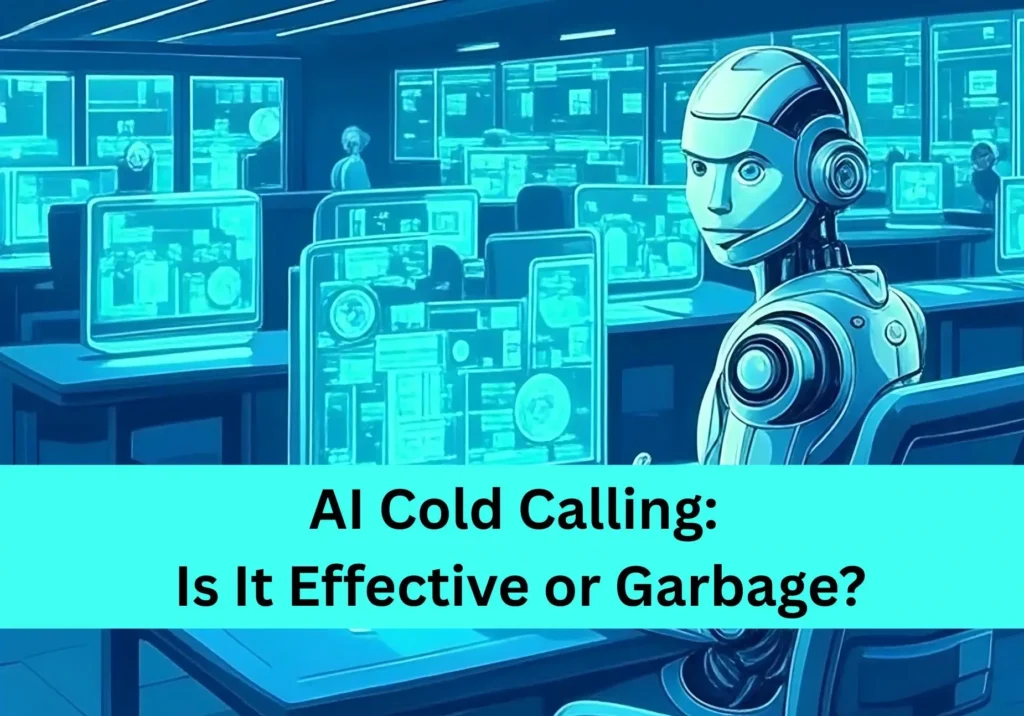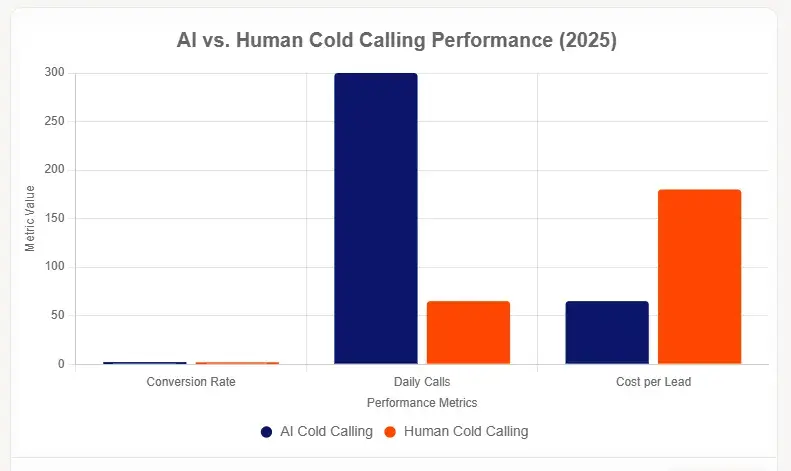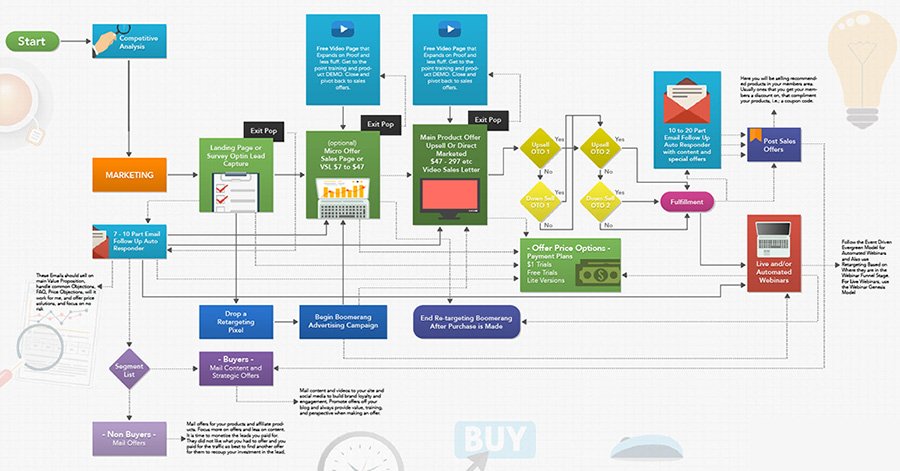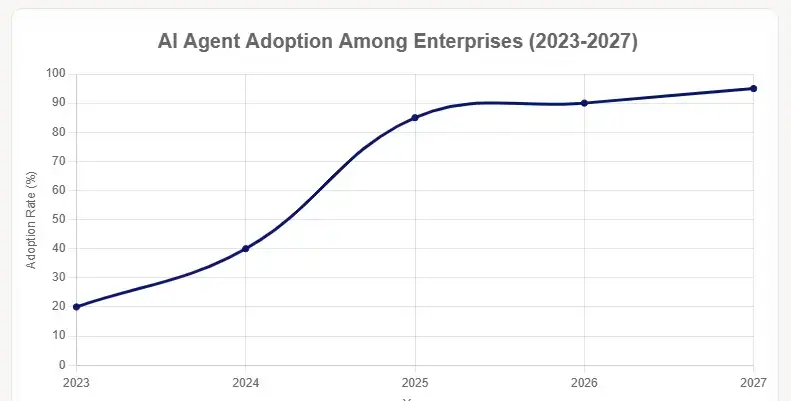AI Cold Calling in 2025: Is It Effective?
Your sales team just finished another brutal day of cold calling.
Rejection after rejection.
Voicemails that never get returned.
And that familiar feeling of dread every time they have to pick up the phone.
What if I told you there’s technology right now that can make hundreds of cold calls per day with zero fatigue, handle objections better than your best salesperson, and convert prospects at rates that would make your current team jealous?
You’d probably think I’m overselling it. That’s exactly what we thought too, until we started implementing AI voice agents for our web design clients and watched their sales numbers explode.
The numbers are staggering. The voice AI agents market is projected to hit $47.5 billion by 2034, riding a massive 34.8% growth rate.
But here’s the kicker… most businesses have no clue this technology even exists, let alone how powerful it’s become.

Let’s dive in.
CONTENTS
What AI Cold Calling Actually Looks Like Right Now
Let’s cut through the hype and talk about what’s really happening.
These aren’t the robotic telemarketing calls from the 90s. We’re talking about AI agents that sound so human, prospects often don’t realize they’re talking to a machine until the call is over.
Modern AI cold calling combines natural language processing, machine learning, and predictive analytics to create conversations that feel completely natural. The AI doesn’t just read from a script. It listens, understands context, handles objections in real-time, and adapts its approach based on how the prospect responds.
What Blew Our Minds When We First Saw This in Action:
- Real-Time Conversation Intelligence – The AI agent hears a prospect say “I’m not interested” and instantly analyzes their tone, the specific words they used, and the timing of their response. Based on that analysis, it chooses from thousands of possible responses – not scripted replies, but genuinely contextual comebacks that address the specific concern.
- Emotional Intelligence That Actually Works – When a prospect sounds frustrated, the AI picks up on vocal cues and shifts to a more empathetic tone. When someone seems curious but cautious, it slows down and provides more detailed explanations. This isn’t programmed responses – it’s real emotional analysis happening in milliseconds.
- Perfect Memory and Instant Access – Every AI agent has perfect recall of every conversation, every objection, and every successful approach. It learns from every single call and applies that knowledge immediately to the next conversation.
The technology stack behind this is impressive, but what matters is the results.
The Performance Numbers That Change Everything
You want proof this actually works? Let’s talk numbers.
Conversion Rate Reality Check
Companies using conversational AI are seeing up to 10% higher conversion rates compared to traditional cold calling. That might not sound earth-shattering until you realize what that means for your bottom line.
If your current cold calling converts 2% of prospects, jumping to 2.2% means 10% more sales with the same effort. For a business making 1,000 calls per month, that’s 20 additional conversions. Scale that across a year, and you’re looking at 240 extra sales.
Volume Capabilities That Defy Logic
Here’s where it gets crazy. AI agents can handle calls 24/7 without breaks, sick days, or vacation time. While your human sales team makes maybe 50-80 calls per day, a single AI agent can make 300+ calls daily with consistent energy and enthusiasm.
One of our clients went from 400 cold calls per week with their human team to over 2,000 calls per week after implementing AI agents. Same marketing budget, five times the outreach volume.
Cost Analysis That Makes CFOs Smile
The math is brutal for traditional sales teams:
Traditional Sales Rep Annual Cost:
- Base salary: $50,000+
- Benefits and taxes: $15,000+
- Training and onboarding: $5,000+
- Management overhead: $10,000+
- Total: $80,000+ per year
AI Agent Annual Cost:
- Platform fees: $6,000-24,000
- Implementation: $10,000-20,000 (one-time)
- Monthly optimization: $12,000-36,000
- Total: $28,000-80,000 per year
Even if the AI agent only performs at 70% the effectiveness of your best human caller, the ROI is insane when you factor in the volume capability and operational costs.
A/B Testing Results from Real Implementations
Blind A/B tests are showing superior performance metrics across the board:
- Longer call durations
- Higher resolution rates
- Better revenue recovery rates
- Improved customer satisfaction scores
That last point surprised everyone.
Customers are actually more satisfied talking to AI agents than human callers in many scenarios. Why? The AI never has a bad day, never gets pushy when they’re behind on quota, and always has time to answer questions thoroughly.

The Legal Landscape You Need to Know
Before you get too excited, let’s address the elephant in the room – regulations.
The FCC (US) and ISED (Canada) requires disclosure when AI is making calls. But here’s what most people don’t understand: this requirement actually works in your favor when implemented correctly.
Smart companies are using the disclosure as a selling point. “Hi, this is Sarah, an AI assistant calling on behalf of ABC Company. I know you’re busy, so I’ll be direct about why I’m calling and respect your time.”
This approach actually increases trust and engagement. Prospects appreciate the honesty, and it positions your company as innovative and transparent.
The key is compliance with local laws and industry regulations. Each industry has specific requirements, and proper implementation ensures you’re not just legal, but using the regulations strategically.

Market Explosion Most Businesses Are Missing
The numbers paint a picture that should terrify your competition and excite you.
85% of enterprises will use AI agents by 2025, but most are still in the planning or early adoption phase.
You know what that means? We’re in the early adopter phase right now. The businesses implementing AI cold calling today are going to have a massive competitive advantage for the next 2-3 years while their competitors figure out what hit them.
Voice agent companies represented 22% of the most recent Y Combinator class. That’s a massive shift in startup funding priorities, and it signals where smart money thinks the market is heading.
But here’s the thing… most businesses don’t know how to implement this technology. They know it exists, they’ve read articles and watched videos about it, but they have no idea how to actually set it up and integrate it with their existing systems.
That’s where the opportunity lies.

Why We Became AI Implementation Partners
This is where things get interesting for businesses and their growth partners.
We already handles the technical infrastructure that businesses rely on. We understand APIs, integrations, databases, and user experience design. Those same skills translate perfectly to AI agent implementation and AI growth infrastructure development.
The Technical Integration Challenge
AI voice agents don’t operate in isolation. They need to integrate with:
- CRM systems for lead management
- Appointment scheduling tools for seamless booking
- Payment processors for immediate transactions
- Marketing automation platforms for follow-up sequences
- Analytics dashboards for performance tracking
Sound familiar? It’s the same type of technical project management we do for complex digital marketing implementations.
The Infrastructure Requirements
Most businesses don’t realize that effective AI cold calling requires significant backend infrastructure. You need proper data management, call routing systems, analytics dashboards, and integration workflows.
This isn’t something you set up in an afternoon. It’s a legitimate technical project that requires planning, implementation, testing, and ongoing optimization. Just like AI receptionists, successful AI sales implementations require careful integration with existing business systems.
The Optimization Opportunity
Here’s what separates successful AI implementations from failures – continuous optimization based on real performance data.
The AI agents generate massive amounts of data about what works and what doesn’t. Successful implementations require someone who can analyze that data, identify improvement opportunities, and implement changes systematically.
Companies like iConnect Media already do this type of performance optimization for digital marketing campaigns. The same analytical approach applies to AI agent optimization.

Real-World Implementation Examples
Let me share some examples from our client work (details changed to protect confidentiality).
Case Study 1: Local HVAC Company
Previous setup: 2 full-time sales reps making about 300 calls per week combined, converting roughly 3% to appointments.
AI implementation: Single AI agent making 150+ calls per day (750+ per week), converting 4.2% to qualified appointments.
Results after 3 months:
- 150% increase in appointment volume
- 40% reduction in cost per appointment
- Sales team can focus on closing instead of prospecting
Case Study 2: Financial Services Firm
Previous setup: Expensive lead generation services plus human follow-up team, $180 cost per qualified lead.
AI implementation: AI agents for initial outreach and qualification, with warm transfers to human agents for closing.
Results after 6 months:
- Cost per qualified lead dropped to $65
- Lead volume increased 220%
- Closing rates improved because leads were better qualified
Case Study 3: B2B Software Company
Previous setup: SDR team of 4 people, struggling to scale outreach efforts.
AI implementation: AI agents for initial outreach, appointment setting, and basic qualification.
Results after 4 months:
- Same appointment volume with 2 SDRs instead of 4
- SDRs now focus on complex deals and relationship building
- Overall pipeline increased 180%

The Technology Platforms Leading the Revolution
Several platforms are making this technology accessible to businesses of all sizes.
Bland AI has created a platform that makes it incredibly easy to build and deploy voice agents. Their API-first approach means we can integrate AI calling into existing business systems without major overhauls.
Synthflow focuses on conversational AI that handles complex business scenarios. Their agents can navigate multi-step conversations, handle objections, and even process payments over the phone.
Cartesia provides the underlying voice technology that makes AI agents sound natural and engaging. Their real-time voice synthesis is what makes the conversations feel human.
The key insight? You don’t need to build this technology from scratch. These platforms provide the foundation, and implementation partners like us handle the customization and integration.
What Success Actually Requires
Here’s what we’ve learned from implementing dozens of AI agent systems:
Critical Success Factors
- Data Quality Is Everything Garbage in, garbage out. The AI is only as good as the prospect data you feed it. Clean, well-segmented lists with good contact information are essential.
- Script Development Is An Art You’re not writing scripts for humans – you’re creating conversation frameworks for AI. This requires understanding both persuasion psychology and how AI processes language.
- Integration Planning Is Critical
The AI agent is just one piece of your sales ecosystem. Success requires seamless integration with your CRM, scheduling system, and follow-up processes. - Continuous Optimization Is Required Initial setup is just the beginning. Successful implementations require ongoing analysis, testing, and refinement based on real performance data.
- Compliance Must Be Built In Legal requirements vary by industry and location. Proper implementation builds compliance into the system architecture, not as an afterthought.

The Cost Reality Check
Let’s talk real numbers for implementation.
- Platform Costs: Most AI voice platforms charge based on usage – typically $0.10-0.50 per minute of talk time. For a business making 1,000 calls per month with 5-minute average conversations, that’s $500-2,500 monthly.
- Implementation Costs: Professional setup including integration, script development, and testing typically runs $5,000-15,000 depending on complexity.
- Ongoing Optimization: Monthly optimization and management services usually cost $1,000-3,000 depending on call volume and complexity.
- Total First Year Cost: $15,000-40,000 for a comprehensive implementation with ongoing optimization.
Compare that to hiring additional sales staff: $50,000+ per person in salary alone, plus benefits, training, management overhead, and the time required to get them productive.
The ROI math works for most businesses doing significant cold outreach.

Getting Started: The Implementation Roadmap
Ready to explore this for your business? Here’s the step-by-step process we use:
Phase 1: Assessment and Planning (Week 1-2)
- Analyze current sales process and identify integration points
- Review prospect data quality and segmentation
- Define success metrics and KPIs
- Create compliance requirements checklist
- Select appropriate AI platform based on needs
Phase 2: Foundation Setup (Week 3-5)
- Configure AI platform and basic settings
- Set up integrations with existing systems
- Develop initial conversation frameworks
- Create testing and optimization protocols
- Build analytics and reporting dashboards
Phase 3: Script Development and Training (Week 6-8)
- Develop conversation flows for different prospect types
- Create objection handling frameworks
- Build qualification criteria and routing rules
- Train AI on industry-specific terminology
- Set up compliance and disclosure protocols
Phase 4: Testing and Refinement (Week 9-11)
- Run controlled test campaigns with small prospect segments
- Analyze conversation quality and conversion rates
- Refine scripts and conversation flows based on results
- Optimize technical performance and integration workflows
- Train team on monitoring and basic optimization
Phase 5: Launch and Scale (Week 12+)
- Deploy AI agents with full prospect lists
- Monitor performance and make real-time adjustments
- Scale successful approaches across larger segments
- Implement ongoing optimization protocols
- Plan expansion to additional use cases
The Competitive Advantage Window
Here’s something most businesses don’t realize, we’re in a narrow window where early adoption provides massive competitive advantage.
Right now, most of your competitors are either unaware of this technology or stuck in analysis paralysis trying to figure out how to implement it.
The businesses that implement AI cold calling in 2025 will have 2-3 years of competitive advantage while their competitors catch up. But that window is closing.
Market adoption is accelerating rapidly, and the platforms are becoming more user-friendly every month. In 2-3 years, AI cold calling will be table stakes, not a competitive advantage.
The question isn’t whether this technology will become standard – it’s whether you’ll be ahead of the curve or playing catch-up.

Common Objections and Reality Checks
Let’s address the concerns we hear most often:
“Our prospects will hate talking to robots”
The data says otherwise. When implemented correctly with proper disclosure, customer satisfaction often improves. The AI doesn’t have bad days, doesn’t get pushy when behind on quota, and always has time to answer questions.
“It’s too expensive for our business”
Compare the total cost to hiring additional sales staff. Even if the AI only performs at 60% of human effectiveness, the volume capability and cost structure usually provide better ROI.
“The technology isn’t ready yet”
This was true 2 years ago. It’s not true anymore. The current platforms are sophisticated enough for real business applications, and they’re improving rapidly.
“We need human relationships for our sales”
AI agents don’t replace relationship building – they handle the initial prospecting and qualification that humans hate doing anyway. Your sales team can focus on building relationships with qualified prospects instead of making hundreds of cold calls.
“It’s too complicated to implement”
That’s exactly why implementation partners exist. The technology is complex, but working with experienced implementers makes it manageable.
The Implementation Partner Advantage
This is where companies like us have a unique opportunity.
We already understand the technical complexity of integrating different systems. We’re used to managing projects that require careful planning, testing, and optimization. We know how to translate business requirements into technical solutions.
AI agent implementation requires exactly these same skills, plus the strategic insight to build comprehensive AI growth infrastructure that scales with your business.
The businesses that succeed with AI cold calling aren’t necessarily the ones with the biggest budgets – they’re the ones that partner with implementers who understand both the technology and the business strategy.
What’s Coming Next
The AI cold calling space is evolving rapidly. Here’s what we’re seeing on the horizon:
Emerging Capabilities
- Multi-Modal Conversations – AI agents that can switch seamlessly between voice, text, and video based on prospect preferences
- Industry-Specific Specialization – Platforms optimized for specific industries with built-in compliance and terminology
- Advanced Emotional Intelligence – AI that can detect and respond to complex emotional states with increasing sophistication
- Predictive Optimization – Systems that predict the best times to call, optimal conversation approaches, and highest-probability prospects based on massive datasets
- Integration Ecosystems – Deeper integration with CRM platforms, marketing automation tools, and business intelligence systems
The businesses that establish AI cold calling capabilities now will be positioned to take advantage of these advances as they become available.
Your Next Steps
The opportunity is clear. The technology is ready.
The question is whether you’re going to be ahead of the curve or playing catch-up in 2-3 years when this becomes standard practice.
If you’re serious about exploring AI cold calling for your business, here’s what we recommend:
Start with a consultation to assess your current sales process and identify where AI agents could provide the biggest impact. Look at your prospect data quality, current conversion rates, and cost per acquisition.
Evaluate whether your business has the volume to justify implementation. Generally, businesses making 500+ cold calls per month see the best ROI.
Consider partnering with an experienced implementer rather than trying to figure this out internally. The learning curve is steep, and mistakes in the early stages can be expensive.
Plan for this as a 3-6 month project, not a quick fix. Successful implementations require careful planning, testing, and optimization.
The businesses dominating their markets in 2026 will be the ones that figured this out in 2025.
The Bottom Line
AI cold calling isn’t science fiction anymore. It’s a practical business tool that’s delivering real results for companies smart enough to implement it correctly.
The technology has reached the point where it’s not a question of “if” but “when” this becomes standard practice. The businesses that move first will have a significant competitive advantage while their competitors figure out what hit them.
The window for early adoption advantage is open right now, but it won’t stay open forever.
Your competitors are either already implementing this technology or they’re about to start. The question is whether you’ll be leading the market or following it.
If you’re ready to explore how AI cold calling could transform your sales results, the time to start is now. The technology is ready, the platforms are proven, and the implementation expertise is available.
The only question left is whether you’re ready to take advantage of it.
FAQs
How does AI cold calling differ from traditional cold calling?
AI cold calling uses advanced algorithms and machine learning to automate and optimize outreach. Unlike traditional methods, AI tools analyze prospect data to personalize scripts, predict the best call times, and even handle initial conversations via voice bots, saving time and boosting conversion rates.
Can AI cold calling tools sound natural and human-like?
Yes, modern AI cold calling platforms leverage natural language processing (NLP) to mimic human speech patterns, tone, and context. These tools are trained on vast datasets to ensure conversations feel authentic, reducing the risk of prospects feeling like they’re talking to a robot.
What kind of results can I expect from using AI for cold calling?
Results vary, but businesses using AI cold calling often report 30-50% higher call efficiency, 20% more qualified leads, and up to 40% reduced costs compared to manual calling. AI’s ability to analyze data and optimize in real-time drives these improvements.
Is AI cold calling compliant with regulations like TCPA or GDPR?
Reputable AI cold calling tools are designed with compliance in mind, offering features like automated opt-out management and consent tracking. However, it’s critical to configure these tools correctly and stay updated on local regulations to avoid penalties.
Do I need technical expertise to implement AI cold calling in my business?
You can set up a simple version of AI cold calling on your own with user-friendly platforms that integrate with CRMs like Salesforce or HubSpot. However, to maximize results, it’s recommended to work with an expert who can customize and optimize the system for your specific needs









